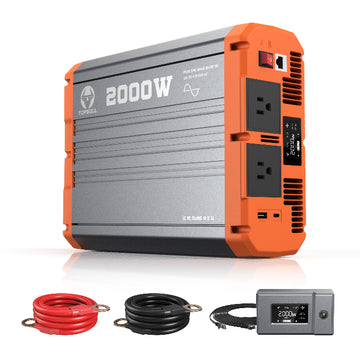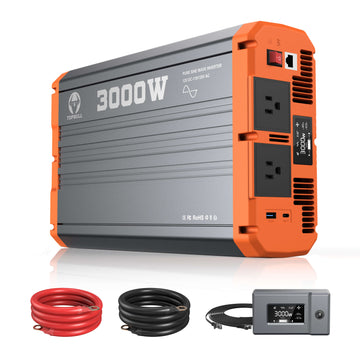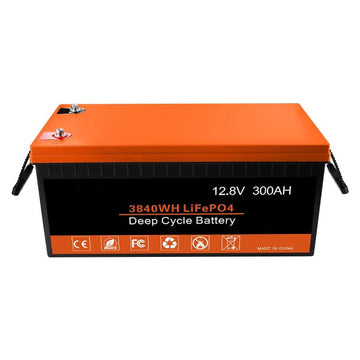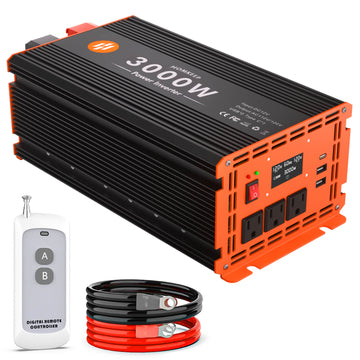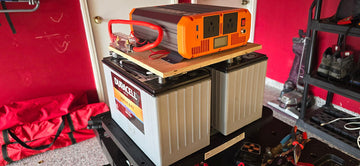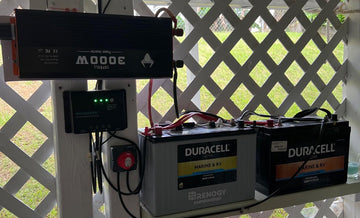Lithium-ion batteries play an important role in modern technology due to their outstanding performance and wide range of applications. Whether it is a portable electronic device, a Tesla electric car, or a home energy storage system, the voltage characteristics of Li-ion batteries are a key factor in their efficiency and stability. This article will explore the voltage characteristics of 12V, 24V, and 48V lithium-ion batteries in detail, providing an in-depth understanding of battery performance.
Table of contents:
- Understanding Lithium Ion Battery Voltage
- Lithium-ion batteries with different voltage ratings
- Lithium Ion Battery Voltage Chart
- 12V Lithium Battery Voltage Chart
- Lithium Ion Battery SoC Chart
- Lithium-ion Battery Voltage Curve
- LiFePO4 Battery Charging and Discharging
- Lithium battery voltage changes under different conditions
- The impact of lithium battery voltage on battery performance
- Lithium-ion Battery Management System and Battery Voltage
- Best LiFePO4 battery recommendation
- FAQs
Understanding Lithium Ion Battery Voltage
A lithium-ion battery is a battery that stores and releases electrical energy through the migration of lithium ions between the positive and negative electrodes. Its typical structure consists of a positive electrode (usually lithium cobalt oxide or lithium iron phosphate), a negative electrode (usually graphite) and an electrolyte. With high energy density, low self-discharge rate and long cycle life, lithium-ion batteries are widely used in cell phones, laptops, electric vehicles and energy storage systems.
The voltage of a lithium-ion battery is the potential difference between the battery terminals during charging and discharging. The change of voltage directly affects the energy output, charging efficiency and service life of the battery. Different types of lithium-ion batteries use different chemistries, resulting in nominal voltages at different voltage levels. For example, common lithium-ion batteries have a nominal voltage of 3.7V, but in applications, the cells are constructed into battery packs to meet higher voltage requirements.
Lithium-ion batteries with different voltage ratings
Lithium-ion batteries are usually categorized into 12V, 24V, and 48V voltage ratings. of which:
- 12V lithium-ion batteries : suitable for small electronic devices, drones and some home energy storage devices. It has the advantages of lower cost and easy to use.
- 24V Li-ion batteries : Widely used in electric cars, electric scooters and solar energy storage systems, providing higher power output and energy efficiency.
- 48V Li-ion batteries: Typically used in high power devices and systems such as electric vehicles and large scale energy storage solutions. Their high energy output is suitable for a wide range of complex applications.
Lithium Ion Battery Voltage Chart
Lithium-ion batteries are available in different voltage sizes, the most common being 12 volts, 24 volts, and 48 volts. Each API has a different voltage rating for a specific discharge capacity.
It is also helpful to know the voltage and discharge rate of a lithium battery. Use the battery voltage charts below to determine the discharge chart for each cell.
| Charge Capacity (%) | Voltage (1 Cell) | Voltage (12 Volt) | Voltage (24 Volt) | Voltage (48 Volt) |
| 100 | 3.40 | 13.6 | 27.2 | 54.4 |
| 90 | 3.35 | 13.4 | 26.8 | 53.6 |
| 80 | 3.32 | 13.3 | 26.6 | 53.1 |
| 70 | 3.30 | 13.2 | 26.4 | 52.8 |
| 60 | 3.27 | 13.1 | 26.1 | 52.3 |
| 50 | 3.26 | 13.0 | 26.0 | 52.2 |
| 40 | 3.25 | 13.0 | 26.0 | 52.0 |
| 30 | 3.22 | 12.9 | 25.8 | 52.5 |
| 20 | 3.20 | 12.8 | 25.6 | 51.2 |
| 10 | 3.00 | 12.0 | 24.0 | 48.0 |
| 0 | 2.50 | 10.0 | 20.0 | 40.0 |
12V Lithium Battery Voltage Chart
Typically, a battery voltage chart represents the relationship between two key factors - the battery's SoC (state of charge) and the battery's operating voltage. The following table illustrates a 12V lithium-ion battery voltage chart (also known as a 12-volt battery voltage chart).
| Percentage of Charge | 12V Battery Voltage | Specific Gravity using Hydrometer |
| 100% | 12.70 | 1.265 |
| 90% | 12.58 | 1.249 |
| 80% | 12.46 | 1.233 |
| 70% | 12.36 | 1.218 |
| 65% | 12.28 | 1.204 |
| 50% | 12.20 | 1.190 |
| 40% | 12.12 | 1.196 |
| 30% | 12.04 | 1.162 |
| 20% | 11.98 | 1.148 |
| 10% | 11.94 | 1.134 |
| 0%(Discharged) | 11.90 | 1.120 |
Lithium Ion Battery SoC Chart
When a lithium-ion battery is inserted into the charger, it continues to charge until it reaches 100% state of charge. The charge is then terminated and the Li-Ion battery is allowed to slowly discharge. In Li-Ion batteries, the relationship between SoC and voltage is relatively flat over the entire discharge range of the battery. This is a diagram of the state of charge of a Li-Ion battery:

Lithium-ion Battery Voltage Curve
A typical lithium ion battery voltage profile is a relationship between voltage and state of charge. When the battery is discharged and current is supplied, the anode releases lithium ions to the cathode to create a flow of electrons from one side to the other. The charge and discharge curves of lithium-ion batteries vary by type.

LiFePO4 Battery Charging and Discharging
| Characteristics | 12V | 24V | 36V | 48V |
| Charging Voltage | 14.2-14.6V | 28.4V-29.2V | 42.6V~43.8V | 56.8V-58.4V |
| Float Voltage | 13.6V | 27.2V | 40.8V | 54.4V |
| Maximum Voltage | 14.6V | 29.2V | 43.8V | 58.4V |
| Minimum Voltage | 10V | 20V | 30V | 40V |
| Nominal Voltage | 12.8V | 25.6V | 38.4V | 51.2V |
Lithium battery voltage changes under different conditions
The voltage of a lithium-ion battery is not fixed; it changes according to several factors. These factors include ambient temperature, load conditions, and the state of charge and discharge of the battery. Understanding these variations is critical to the performance and life of the battery.
1. Temperature Effects
High Temperature: When the temperature rises, the chemical reaction inside the lithium-ion battery accelerates and the battery voltage may rise. Although the battery may show better performance for a short period of time, prolonged use at high temperatures will accelerate battery aging, reduce safety, and may even lead to thermal runaway.
Low temperature: Under low temperature conditions, the internal resistance of lithium batteries increases, and the discharge capacity of the battery decreases, resulting in a significant decrease in voltage. Usually, the environment below 0℃ will cause the voltage to be too low, affecting the power output of the battery, and even in extreme cases, it may lead to the battery can not be discharged.
2. Load Impact
Light load: Under a small load, lithium batteries can maintain a relatively stable voltage output. Due to the small current consumption, the voltage fluctuation of the battery is small and most of it can be kept within the normal working range.
Heavy Load: Under high load conditions, the voltage of the Li-ion battery will drop instantly due to the high current demand. In this case, the internal chemistry of the battery may not be able to keep up in time, resulting in a temporary drop in battery voltage. Although this is usually temporary, it can affect the health and life of the battery if it continues for too long.
3. Charging Process
Charging Stage: During the charging process, the voltage of the lithium battery will rise continuously, and the change of voltage will be different according to the different charging modes. When using constant current charging, the battery voltage will rise faster; while in constant voltage charging state, the battery voltage will be kept at a higher level near the completion of charging.
End of Charge: When a Li-ion battery is charging close to full capacity, the voltage will rise rapidly to reach a peak (usually about 4.2V), and if charging continues at this time, it may cause damage to the battery. Therefore, modern battery management systems will intelligently manage charging to avoid overcharging.
4. Self-discharge
Lithium-ion batteries also experience some degree of self-discharge when not in use, resulting in a slow drop in battery voltage. The rate of self-discharge is affected by the type of battery and the storage environment, e.g. higher temperatures can accelerate self-discharge. Therefore, checking the battery voltage regularly is key to ensuring the health of your battery.
The impact of lithium battery voltage on battery performance
Lithium battery voltage has a critical impact on battery performance, mainly reflected in the following aspects:
Performance
Output power and energy storage:
- The higher the voltage of the lithium battery, the higher its output power is usually, which means that under the same conditions, high voltage batteries can release energy faster.
- The voltage also directly affects the battery's power storage capacity. Generally speaking, higher voltage batteries are able to store more power, thus providing longer usage when needed.
Overall Performance:
- Voltage consistency is critical to the overall performance of a lithium battery pack. In a battery pack, if there is a difference in the voltage of a single cell, then during the charging and discharging process, certain cells may reach their upper or lower voltage limits earlier, resulting in the whole battery pack not being able to fully utilize its capacity, thus reducing the overall energy efficiency.
Safety
Risk of thermal runaway:
- High voltage may cause the internal temperature of the battery to rise, increasing the risk of thermal runaway. Thermal runaway is a safety accident triggered by the inability to effectively dissipate the heat inside the battery after it has accumulated to a certain level, which may lead to battery explosion or fire.
- When the voltage is inconsistent, some batteries may have thermal runaway due to overcharging or over-discharging, further increasing the safety risk.
Battery Stability:
- Stable voltage helps to maintain the stability of the battery and reduce the safety risks caused by voltage fluctuations.
Life Impact
Cycle life:
- There is a certain correlation between the life of lithium batteries and the voltage level. If the battery is operated under higher voltage for a long time, its cycle life may be shortened. This is because high voltage accelerates the rate of chemical reaction inside the battery, leading to faster aging of battery materials.
- Conversely, maintaining the proper voltage level will help extend the cycle life of the battery.
Voltage imbalance:
- Voltage imbalance is one of the major causes of shortened battery life. In a battery pack, if the voltage of a single cell varies greatly, certain cells may experience more charge/discharge cycles during the charging and discharging process, resulting in a shorter lifespan, which in turn affects the lifespan of the entire battery pack.
Lithium-ion Battery Management System and Battery Voltage
The lithium-ion battery management system (BMS) is the core component used to monitor and manage the performance of the battery, and battery voltage is an important parameter in its management. The following is a brief overview of the relationship between BMS and battery voltage:
1. Battery Voltage Monitoring
- State of Charge Assessment: The BMS determines the State of Charge (SoC) by measuring the battery voltage, helping the user to understand the remaining charge.
- Health monitoring: Voltage variations can indicate the health status of the battery, and abnormal fluctuations may indicate potential problems.
2. Charging Management
- Constant Current/Constant Voltage Charging: The BMS uses constant current mode and then switches to constant voltage mode during the charging process to ensure that the battery voltage does not exceed the safe range (usually 4.2V).
- Overcharging protection: Monitoring voltage to prevent overcharging, avoiding battery damage and safety risks.
3. Discharge Management
- Over-discharge protection: The BMS monitors the battery voltage to prevent it from dropping below a safe level (usually 3.0V) to protect the battery.
- Load Balancing: In a multi-cell battery pack, the BMS balances the voltage of each cell to ensure even discharge.
4. Temperature Impact
- Temperature Compensation: The BMS can adjust voltage readings based on temperature to more accurately assess battery status.
- Safety strategy: In extreme temperature environments, the BMS adjusts the charging and discharging strategy to protect the battery.
5. Data Communication
- Interface with charger: BMS adjusts the charger according to the information of battery voltage to realize safe charging.
- Interface with management system: In electric vehicles or energy storage systems, data from the BMS helps manage overall energy distribution.
Lithium-ion battery management systems ensure safe and efficient battery operation by monitoring and managing battery voltage. An effective BMS design not only extends the life of the battery, but also improves the safety and reliability of the system.
Best LiFePO4 battery recommendation
12V 100Ah LiFePO4 Lithium Battery,2000~5000 Cycles, Perfect for RV, Off-Grid, Solar Power System

Product Features:
- Long life: LiFePO4 (lithium-iron) batteries last 8 to 10 times longer than conventional lead-acid batteries, with up to 2,000 to 5,000 cycles compared to 300-500 cycles for lead-acid batteries.
- High Energy Density: Compared with lead-acid batteries, their usable capacity is doubled, while their weight is reduced by 30%, thanks to their significantly higher energy density.
- No Memory Effect: Li-ion batteries hold their charge better when not in use and do not lose capacity due to their previous state of discharge.
- Built-in BMS system: The battery has a built-in Battery Management System (BMS) with an excellent self-discharge rate, which protects the battery from damage caused by overcharging, over-discharging, over-current and short-circuit. Also, the built-in high temperature cut-off prevents charging temperatures from exceeding 122°F (50°C).
- Safer: Lithium-ion batteries are safer than lead-acid batteries, which have no ground fault protection.
- Expandable Capacity: Batteries can be connected in parallel and series to increase capacity and voltage. The maximum number of series connections is four identical batteries up to 48V, and the maximum number of parallel connections is four identical batteries up to 800AH.At the same time, the batteries can be connected in parallel and series at the same time, up to 48V 800AH.However, it should be noted that only the batteries with the exact same voltage and capacity and purchased within six months can be connected in parallel or series.
- Widely used: this lithium battery can be widely used in home energy storage systems, uninterruptible power supply (UPS) backup, lighting, digital/CCTV cameras, portable TVs, electronic robots, electric cars, DIY speakers, 12V routers, air pumps, fishfinders, golf carts, tugboat motors, RVs/campers and yachts, travel trailers, dump trailers, and many other fields.
FAQs
What is the normal operating voltage range of a lithium-ion battery?
The normal operating voltage range for Li-ion batteries is usually between 3.0V and 4.2V. 3.0V is the minimum safe discharge voltage for batteries, while 4.2V is a safe upper charge limit.
Why is it safe to charge lithium batteries to 4.2V?
4.2V is the standard maximum charging voltage for Li-ion batteries. When charging to this voltage, the chemical reaction inside the battery can be carried out safely without causing overheating or damage. However, exceeding this voltage range for a long time may shorten the battery life.
Why can't lithium batteries be over-discharged?
Over-discharge will cause the voltage of the lithium battery to drop below 3.0V, which may permanently damage the internal chemistry of the battery, resulting in reduced capacity and limited performance.
How to determine the charge status of lithium battery?
The charge status of lithium battery can be judged by voltage measurement. Generally, 4.2V indicates a full charge, 3.7V indicates a moderately charged battery, while 3.0V or less indicates an undercharged battery.
How does the voltage of a lithium battery change in a low temperature environment?
The voltage performance of Li-ion batteries usually decreases in low temperature environments. This may result in lower discharge capacity and voltage output of Li-ion batteries in low temperature conditions.
Does the voltage of Li-ion battery change with usage time?
Yes, with the use of Li-ion batteries, especially after many charge/discharge cycles, their internal resistance may increase, resulting in a voltage drop (i.e., “voltage degradation”) under the same load.

